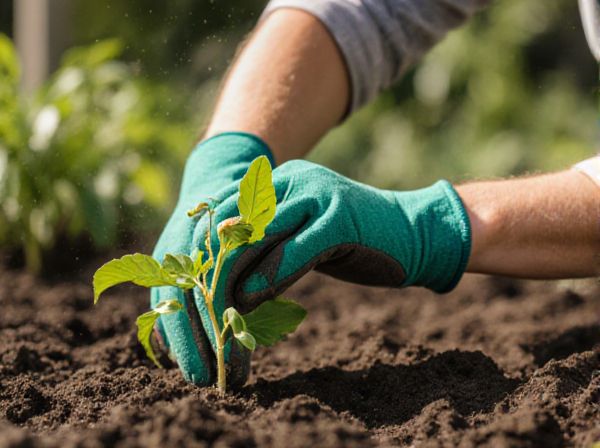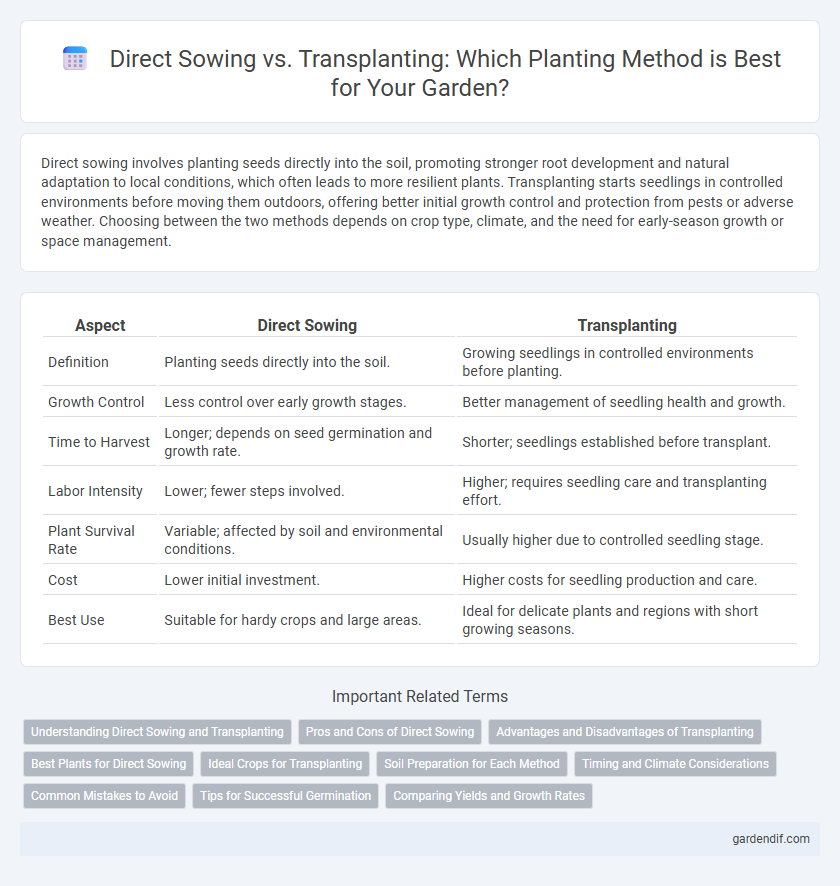
Direct Sowing vs Transplanting Illustration
Direct sowing involves planting seeds directly into the soil, promoting stronger root development and natural adaptation to local conditions, which often leads to more resilient plants. Transplanting starts seedlings in controlled environments before moving them outdoors, offering better initial growth control and protection from pests or adverse weather. Choosing between the two methods depends on crop type, climate, and the need for early-season growth or space management.
Table of Comparison
| Aspect | Direct Sowing | Transplanting |
|---|---|---|
| Definition | Planting seeds directly into the soil. | Growing seedlings in controlled environments before planting. |
| Growth Control | Less control over early growth stages. | Better management of seedling health and growth. |
| Time to Harvest | Longer; depends on seed germination and growth rate. | Shorter; seedlings established before transplant. |
| Labor Intensity | Lower; fewer steps involved. | Higher; requires seedling care and transplanting effort. |
| Plant Survival Rate | Variable; affected by soil and environmental conditions. | Usually higher due to controlled seedling stage. |
| Cost | Lower initial investment. | Higher costs for seedling production and care. |
| Best Use | Suitable for hardy crops and large areas. | Ideal for delicate plants and regions with short growing seasons. |
Understanding Direct Sowing and Transplanting
Direct sowing involves planting seeds directly into the ground, allowing plants to germinate and grow in their natural environment. Transplanting requires starting seedlings indoors or in controlled settings before moving them to the garden, which can enhance growth control and reduce early-stage plant stress. Choosing between direct sowing and transplanting depends on factors like crop type, climate, and desired growth speed.
Pros and Cons of Direct Sowing
Direct sowing promotes stronger root systems by allowing plants to establish in their permanent location, reducing transplant shock and labor costs. However, this method faces higher risks from pests, poor germination rates, and uneven plant spacing, potentially lowering crop uniformity and yield. It is best suited for hardy seeds and stable soil conditions but may require more precise timing and site preparation.
Advantages and Disadvantages of Transplanting
Transplanting offers the advantage of an extended growing season by starting seedlings indoors, which enhances early plant establishment and reduces vulnerability to adverse weather. This method also allows for better control over spacing and soil conditions, leading to improved crop uniformity and potentially higher yields. However, transplanting demands more labor, careful handling to avoid root disturbance, and higher initial costs compared to direct sowing, which can increase risks of transplant shock and plant stress.
Best Plants for Direct Sowing
Best plants for direct sowing include root vegetables like carrots, radishes, and beets, as well as leafy greens such as lettuce, spinach, and arugula. These plants develop well when seeds are sown directly into the soil because they establish strong root systems and adapt quickly to outdoor conditions. Beans, peas, and corn also thrive with direct sowing due to their rapid germination and growth, minimizing the risk of transplant shock.
Ideal Crops for Transplanting
Tomatoes, peppers, and broccoli are ideal crops for transplanting due to their longer growing seasons and sensitivity to early cold soil conditions. Transplanting these crops ensures a head start, promoting stronger seedlings and higher yields compared to direct sowing. Leafy greens and root vegetables generally perform better with direct sowing, as they are less vulnerable to transplant shock and have shorter growth cycles.
Soil Preparation for Each Method
Direct sowing demands well-loosened, nutrient-rich soil with consistent moisture levels to support seed germination and root development. Transplanting requires soil prepared with enriched organic matter and optimal drainage to reduce transplant shock and promote rapid establishment. Both methods benefit from soil testing to adjust pH and nutrient content according to specific plant requirements.
Timing and Climate Considerations
Direct sowing allows seeds to be planted directly into the soil when the ground temperature reaches the optimal range for germination, ideally between 60-75degF for most vegetables. Transplanting seedlings indoors or in greenhouses enables growers to start plants earlier in cooler climates, extending the growing season and improving timing precision. Climate considerations such as frost dates, soil moisture, and temperature fluctuations heavily influence whether direct sowing or transplanting is more effective for successful plant establishment.
Common Mistakes to Avoid
Direct sowing often leads to uneven seed distribution and poor germination if seeds are planted too deeply or too shallowly. Transplanting errors commonly include disturbing the roots or planting seedlings too late, which can cause shock and stunt growth. Avoid overcrowding in both methods to ensure adequate airflow and reduce disease risks.
Tips for Successful Germination
Selecting high-quality seeds with a high germination rate is crucial for both direct sowing and transplanting methods. Maintaining consistent soil moisture and optimal temperature between 65-75degF (18-24degC) promotes faster seedling emergence. Using a light, well-draining seed-starting mix enhances root development and reduces the risk of damping-off disease, essential for successful germination.
Comparing Yields and Growth Rates
Direct sowing promotes robust root development and often results in higher yields due to minimal transplant shock, especially for crops like beans and carrots. Transplanting accelerates early growth by providing seedlings a controlled environment, enhancing growth rates in crops such as tomatoes and peppers, but may slightly delay overall yield maturity. Yield comparisons reveal direct sowing typically outperforms in open-field conditions, while transplanting offers advantages in shorter growing seasons or regions with unpredictable climate.
Direct Sowing vs Transplanting Infographic

 gardendif.com
gardendif.com